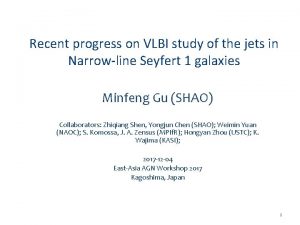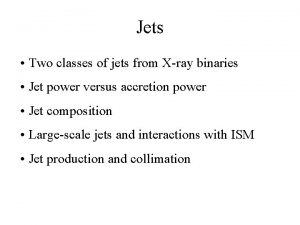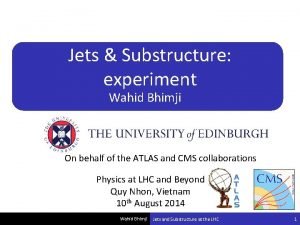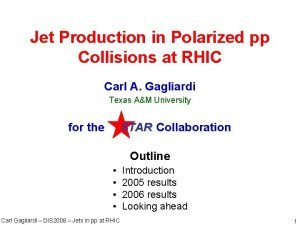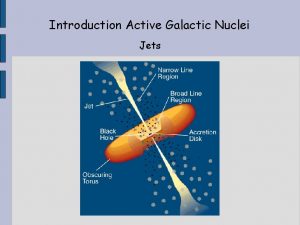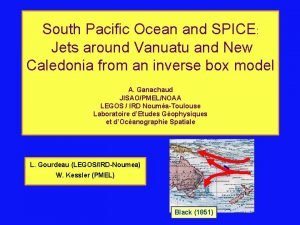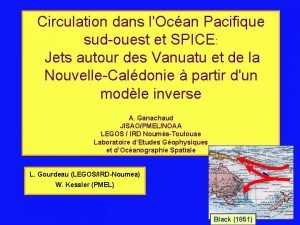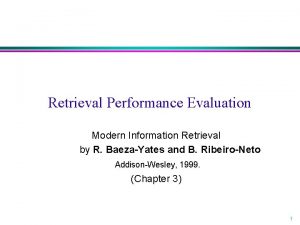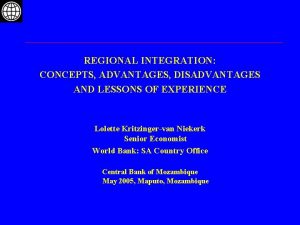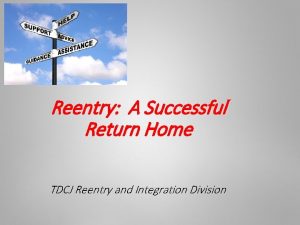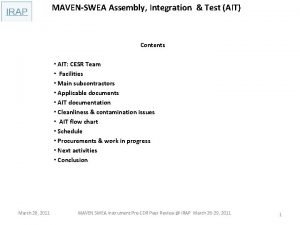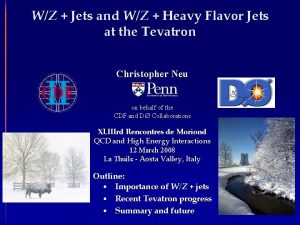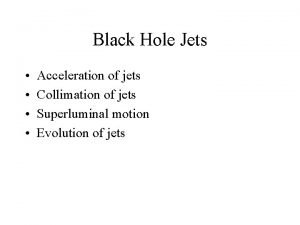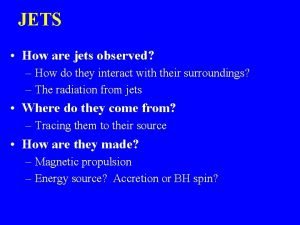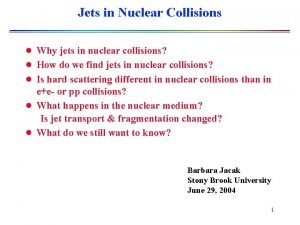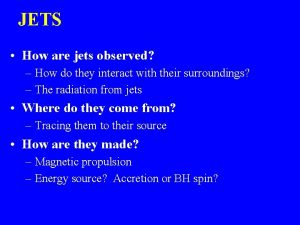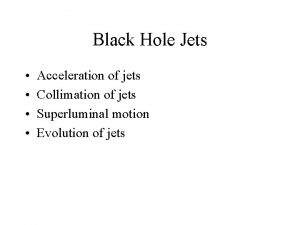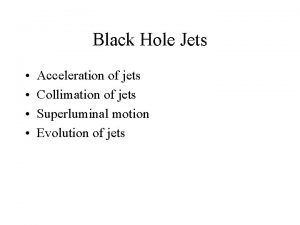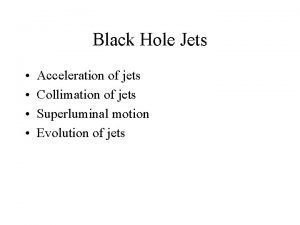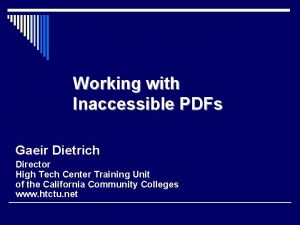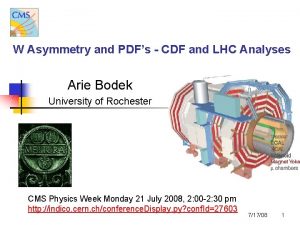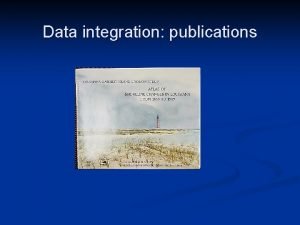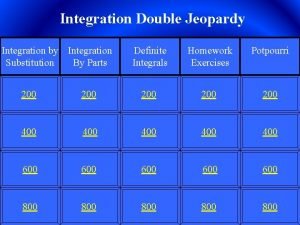High p T Jets and PDFs NLOGRID Integration






















- Slides: 22

High p. T Jets and PDFs (NLOGRID) Integration grids for quick NLO QCD crosssection calculations Dan Clements, Claire Gwenlan, Craig Buttar, G. Salam Tancredi Carli, Amanda Cooper-Sarkar, Mark Sutton, (With the help of Z. Nagy) Dan Clements – ATLAS UK SM meeting (Sep 2006)

Motivation 1. NLO Monte-Carlo QCD calculations are necessary to provide accurate predictions for experimental cross-section measurements. 2. NLO Monte-Carlo calculations however can require long CPU times to achieve sufficient accuracy (typically of order days/weeks). 3. If the PDF is changed the cross-section must be recalculated. This makes it difficult to use data from hadron-colliders to constrain PDFs using iterative techniques. Want a method to separate PDFs from the QCD cross-section calculation………… Dan Clements – ATLAS UK SM meeting (Sep 2006)

Scattering Processes At A Hadron-Collider Hard 2 → 2 scattering Hadron momenta Sum over parton types PDFs Parton momenta Parton Level Cross-Section (we call this ‘weight’ in the following) • The PDFs can be separated from the cross-section by using an integration grid. • The first step to doing this is to represent the PDF by a set of discrete values on a grid… Dan Clements – ATLAS UK SM meeting (Sep 2006)

Representing a PDF on a grid • Consider a proton PDF: q(x, Q 2), where ‘x’ is the parton momentum fraction and ‘Q 2’ is the factorisation scale. • Instead of defining a grid in x and Q 2 perform a co-ordindate transform: • The PDF then becomes: (1) Where the I are interpolation functions of order n and n′. Dan Clements – ATLAS UK SM meeting (Sep 2006)

Representing a PDF on a grid • What is actually going on…. PDF defined at discrete points in x and Q 2 PDF at arbitrary x and Q 2 is described in terms of neighbouring grid points by interpolation. x Dan Clements – ATLAS UK SM meeting (Sep 2006)

LO Monte-Carlo Cross-Sections (DIS) • Consider a Monte-Carlo generator producing N events where each event ‘m’ has x=xm Q 2=Q 2 m and a weight wm. • The cross-section is given by: • But if we believe our interpolation formula we can replace q(xm, Qm 2) in the above by (1). • This is good as the interpolation relies only on the discrete PDF grid points. So we can introduce a weight-grid and for each event update a portion of the grid…… Dan Clements – ATLAS UK SM meeting (Sep 2006)

LO Monte-Carlo Cross-Sections (DIS) • Define a weight-grid in x and Q 2 similar to the PDF grid and for each event update a portion: n. b. have pushed the PDF interpolation onto the MC weights • Can now find the result W for an arbitrary PDF after the Monte. Carlo calculation: Sum over grid entries Weightgrid PDF grid Dan Clements – ATLAS UK SM meeting (Sep 2006)

LO Monte-Carlo Cross-Sections (DIS) What’s actually going on: Q Weightgrid Q 2 PDF grid 2 x Monte Carlo weight is split up into several weights on the grid according to the PDF interpolation formula. x The split weight is multiplied by the corresponding value on the PDF grid after Monte. Carlo production. Dan Clements – ATLAS UK SM meeting (Sep 2006)

Moving to NLO Hadron-Hadron Collisions • For NLO Hadron-Hadron collisions things are a little more complicated: 1. Need to consider two incoming hadrons, hence 2 PDFs and the combinations of partons possible: e. g quark-antiquark, gluon-quark etc, (n. b. use 7 generalised PDF combinations). 2. Need to have grids for both LO and NLO contributions. • Now the grid generated cross-section looks like…… Order 3 D grids Sum over grid points Generalised PDF combinations Dan Clements – ATLAS UK SM meeting (Sep 2006)

Using Integration Grids Step 1: Fill the Grid NLO event generator Event with weight wi, x 1, x 2, Q 2 SLOW Fill Grid with weight wi, at point (x 1, x 2, Q 2) Step 2: Multiply grid by PDFs to generate Cross-Section Grid of weights in (x 1, x 2, Q 2) Multiply and add over (x 1, x 2, Q 2) Jet Cross-Section PDFs defined at (x 1, x 2, Q 2) FAST Fortran interface QCD Fit Dan Clements – ATLAS UK SM meeting (Sep 2006)

Implementing Grids…. • The grid implementation used was developed by Carli, Salam, Siegert and is described in (hep-ph/0510324). • A set of grids is required for calculation of the jet cross-section in a given observable (e. g in p. T) of the cross-section. Need grids for each order: 2 For each subprocess: 7 Total No. grid per observable: 14 • Each grid is split up into 10 bins in x 1, x 2, Q 2 giving 1000 points. • Typical file size of grid is 0. 1 Mb per cross-section and observable bin. • Code is in C++ and makes use of ROOT libraries, although PDF analyses can be easily carried out in FORTRAN if desired. • The grid software currently uses the NLOJET++ generator (Z. Nagy) Dan Clements – ATLAS UK SM meeting (Sep 2006)

A Few More Tricks… • An initial trial run is carried out to optimise the boundaries in x and Q 2 of the grid (for an observable). • The co-ordinate transform is designed to reflect the kinematics of the process concerned (i. e. LHC, more bins at low x, high Q 2) but this can leave the very high x-region under represented. 1. Implement a variable grid spacing: Recall standard co-ordinate transform y=ln(1/x), τ=lnln(Q 2/Λ) 2. Employ PDF reweighting to flatten the PDFs in x and hence improve interpolation accuracy. Dan Clements – ATLAS UK SM meeting (Sep 2006)

How good are the grids? • Compared the inclusive jet cross-section at ATLAS as generated using grids and standard NLO calculation (reference) agreement is better than 0. 2% (y 1, y 2, τ)=(10, 10) Interpolation order 5 Dan Clements – ATLAS UK SM meeting (Sep 2006)

Changing the Renormalisation/Factorisation Scales • The renormalisation and factorisation scales can be changed after grid production (hep-ph/0510324). • One grid can be used to generate cross-sections at arbitrary scales…. . • Shown below is the inclusive jet cross-section at ATLAS for 3 scale choices: 0<y<1 Good agreement between grid calculation and reference calculation using standard NLOJET++ Dan Clements – ATLAS UK SM meeting (Sep 2006)

PDF Fitting Using Pseudodata • Grids were generated for the inclusive jet cross-section at ATLAS in the pseudorapidity ranges 0<η<1, 1<η<2, and 2<η<3 up to p. T=3 Te. V (NLOJET). • In addition pseudodata for the same process was generated using JETRAD [4]. Gluon Fractional Error • The pseudo-data was then used in a global fit to assess the impact of ATLAS data on constraining PDFs and will include TEVATRON data in the future: Preliminary indications suggest that ATLAS data can constrain the high xgluon. Systematic errors are uncorrelated, 10 fb-1=1 year of nominal data-taking at 1033 cm-2 s-1 Dan Clements – ATLAS UK SM meeting (Sep 2006)

Effect Of Increased Statistics on PDF Fits Gluon Fractional Error Increase 10×statistics • Increasing the statistics from 1 fb-1 to 10 fb-1 has little effect on constraining the PDFs at ATLAS. Dan Clements – ATLAS UK SM meeting (Sep 2006)

Effect Of Decreased Systematic Errors On PDF Fits Gluon Fractional Error Decrease (uncorrelated) Systematic errors 10%→ 5% • Decreasing the uncorrelated systematic errors (on the ATLAS experiment) creates a significant improvement in constraining the PDFS. Dan Clements – ATLAS UK SM meeting (Sep 2006)

Boot. Strap Method To Determine JES Error • Standard jet calibration schemes link the hadronic energy scale to the better known EM scale through channels such as Z+jet, γ+jet. • The cross-sections for these processes decrease with p. T, and they become ineffective for determining the JES above p. T~500 Ge. V. Bootstrap Method • Use QCD multijet events to bring the calibration at low p. T up the p. T scale: Well known low p. T jets are used to calibrate high p. T jets by demanding a p. T balance in the transverse plane. High p. T jet p. T>500 Ge. V Low p. T jets • Have to be careful not to introduce a selection bias due to resolution fluctutations. Dan Clements – ATLAS UK SM meeting (Sep 2006)

Very Preliminary! – ATLFAST and PYTHIA results…… • Plotted the means of the distribution p. T(jet) - p. T(jet balanced) in bins of η and jet p. T. In spite of selecting a jet at random there appears to be a bias of ~1% in the balancing procedure…. under investigation…… Dan Clements – ATLAS UK SM meeting (Sep 2006)

Summary • Integration grids using high order interpolation methods can be used to recreate NLO cross-sections to accuracies of better than 0. 02%. • Preliminary results using pseudodata indicate that ATLAS jet data can be useful in constraining the gluon PDF. • Error on gluon PDF that can be extracted from the jet cross-section is dominated by systematics (particularly JES), the statistical error being negligible even for 1 fb-1 Ongoing Developments With Grids And Analysis • Documentation being prepared for grid software and LCG interface. • Software freely available from the authors. • We are willing to provide grids and provide help to interface to existing Fit -package (CTEQ, MRS etc. ) • Bootstrap method of JES determination under investigation Dan Clements – ATLAS UK SM meeting (Sep 2006)

Dan Clements – ATLAS UK SM meeting (Sep 2006)

Dan Clements – ATLAS UK SM meeting (Sep 2006)
 Black hole jets
Black hole jets Jets
Jets Jets
Jets Jets
Jets Parton distribution functions
Parton distribution functions Jets
Jets Spice jets
Spice jets Spice jets
Spice jets Forward integration and backward integration
Forward integration and backward integration Make or buy continuum
Make or buy continuum Simultaneous integration example
Simultaneous integration example Directive supportive leadership
Directive supportive leadership High directive and low supportive behavior
High directive and low supportive behavior High precision vs high recall
High precision vs high recall High precision vs high recall
High precision vs high recall High expectations high support
High expectations high support Low accuracy low precision
Low accuracy low precision Pengertian investasi
Pengertian investasi Multidomestic strategy
Multidomestic strategy Advantages and disadvantages of regional integration
Advantages and disadvantages of regional integration Tdcj reentry program
Tdcj reentry program Swea parts
Swea parts The joint capabilities integration and development system
The joint capabilities integration and development system
